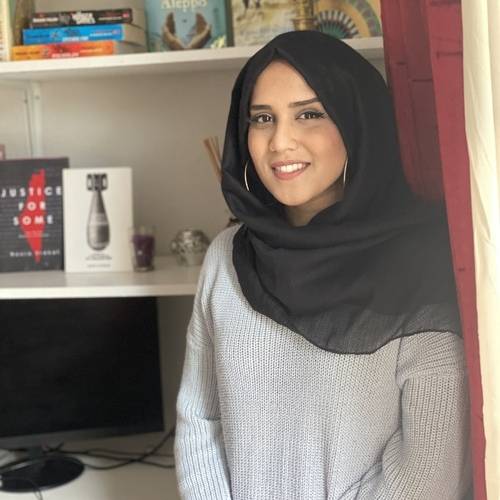As Israel dropped bombs for 15 months and lives were obliterated in Gaza, one woman’s hands had been stitching a tapestry of memory and resistance. Mary Evers, an Irish-born osteopath turned embroidery artist, has embarked on a solemn yet powerful journey to commemorate the Palestinian lives lost in Israel’s genocidal war that killed over 47,500 Palestinians and reduced the enclave to rubble.
Through needle and thread, she is documenting the names of the dead, honouring a tradition deeply rooted in Palestinian culture and creating a community of resilience.
Mary’s connection to the region is deeply personal. Born in 1959, she moved to the Middle East as a child when her father, a multilingual officer in the Irish police force, was deployed as part of a United Nations peacekeeping mission. “We zigzagged across the Mashriq region for two decades,” Mary recalls: “Jerusalem became my hometown.”
Mary’s upbringing in the spiritual and historical epicentre of three major religions vastly differed from the rigid Catholic environment she encountered during trips back to Ireland. “In Jerusalem, religion was just part of who you were, not a tool for division,” she explains.
This inclusive perspective shaped her worldview and cemented her bond with Palestine. “I feel Palestinian in my heart,” she says, a sentiment echoed by her Palestinian brother-in-law, who affirms: “You are one of us.”
INTERVIEW: ‘Gazans evacuated for medical treatment fear they’ll never be allowed back home’
The Gaza Martyrs Project was not born instantly – it crystallised over time. In her retirement, Mary rediscovered a childhood passion for embroidery, a skill influenced by her Palestinian “Dada” (caregiver), Violet, whose family had fled Jaffa. Violet’s mother, an expert in tatreez, traditional Palestinian embroidery, introduced Mary to the art of storytelling through stitches.
But it wasn’t until Mary visited an exhibition by Bangladeshi artist Yasmin Jahan Nupur at London’s Tate Modern that the idea for the project fully materialised. The artist’s embroidered world map of British colonial territories stirred something within her. “It struck me how powerful such a simple act was – using thread to document history and provoke thought,” Mary says.
Mary spent months carefully planning the tapestry. She sourced Egyptian cotton for its durability and nostalgic ties to her childhood when her family’s bed sheets were handmade from the same fabric. “It also symbolises a shroud – honouring the lives lost,” she explains.
To reflect the Palestinian flag, Mary chose specific colour codes for the embroidery. Black threads represent Gaza men, red for women and green for children. The creamy white Egyptian cotton represents the white of the flag. Each panel, even without reading the names, visually conveys the demographic impact of the deaths. Some panels, overwhelmingly green, are a haunting reminder of the countless Gaza children killed.
Her first panel tells the story of the Al-Astal family – 88 members spanning four generations – wiped out by a single bomb. The youngest victim was a newborn; the eldest was 72. “Who is left to mourn these people? Who remembers who they were?” Mary asks.
READ: Doctors fear for life of Gaza hospital chief Abu Safiya held by Israel
Her research led her to an ironic twist: an Irish-born member of the Al-Astal family, whose wife and children were visiting family in Gaza, was heartbroken to find that his wife was among those killed. “It was heartbreaking to realise this family, once so connected, was now fragmented and erased from their homeland’s civil registry.”
The project has blossomed into a collective movement, bringing women together to stitch, share and remember. “Women stitching in groups is an age-old tradition, from quilt-making to tatreez. It creates a space of solidarity and healing,” Mary describes. Each stitch becomes a thread of resistance, weaving a narrative that refuses to let the dead be forgotten.
Reema Farah, a Welsh resident of Palestinian heritage and active advocate in her local community in Swansea, described her initial encounter with the project, “I don’t know how I managed to come across Mary, but I saw a little video she put together, and I just thought, ‘well, that’s definitely something I want to be involved in,’” she said. Despite not considering herself a particularly crafty person, she was drawn to the project’s creative yet solemn mission.
Farah recalled the emotional weight of receiving her assigned panel. “When I actually received it, I took the list out, and I went to go and start to stitch these names or initially write them out. I was completely and utterly overwhelmed by it,” she confessed.
Recognising the enormity of the task, Farah turned to her creative group, Swansea Creatives for Palestine. Together, they stitched over 180 names. “If someone was struggling, we’d share the task. That panel went around each one of us,” she recalled.
The process was deeply moving for Farah. “It was really difficult. I found my own children’s names among those names, and I think you connect more to what that would be like as a mother losing your children.”
Mary emphasises that each name receives about an hour of stitching time. “It’s our way of sitting with each Palestinian martyr, reflecting on who they were, their hopes and dreams.”
The project remains ongoing, with new panels in development and more women joining the collective effort. Through needle and thread, Mary and her collaborators are ensuring that the lives lost in Gaza are neither erased nor forgotten. While Mary plans to limit the project to 30,000 names, the rising death toll may lead to it continuing indefinitely.
INTERVIEW: Virtual reality: Providing injured Gazans an alternative space to heal








